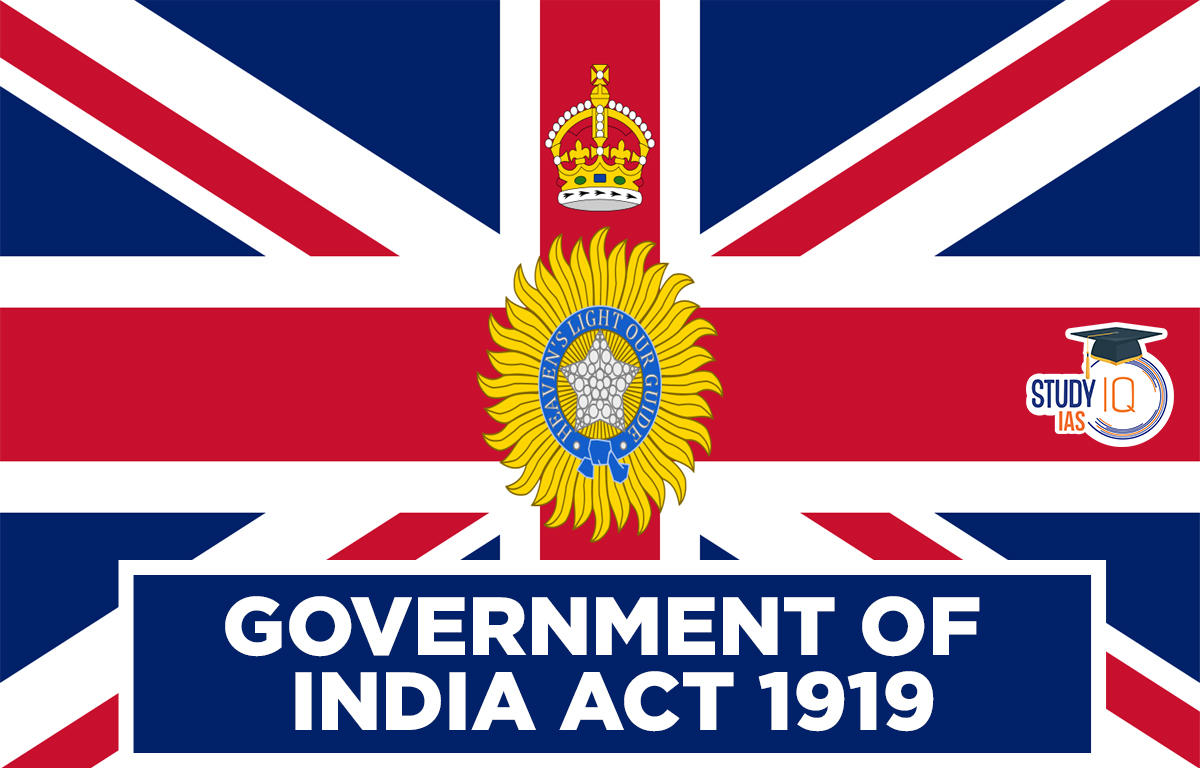Table of Contents
Government of India Act 1919
The Government of India Act of 1919 created the Public Service Commission for the first time in India. The Councils Act of 1919, also known as the Government of India Act of 1919, had as its main objective to promote Indian participation in politics. A dual system of governance was also established by the Act, which divided all operations under governmental authority into two categories. This article goes into great detail regarding the “Government of India Act 1919 and Montague-Chelmsford Reforms,” an important section of the UPSC/IAS Exam Polity and Governance Syllabus.”
Read about: Charter Act of 1833
Government of India Act 1919 or Montague-Chelmsford Reforms
The Government of India Act of 1919 was built on the recommendations of a report that Edwin Montagu provided. Edwin Montagu was India’s secretary of state in 1917. Montagu presented this report to the Cabinet. His goals, which included working for India’s gradual construction of free institutions that will ultimately lead to self-government, were highlighted in the study.
Instead of establishing free institutions, Lord Chelmsford advised Montagu to concentrate on increasing Indian participation in all facets of administration and the gradual growth of self-governing organizations. The ideas from Edwin Montagu and Lord Chelmsford were approved by the Cabinet. Because of this, the Government of India Act (1919) was also known as the Montague-Chelmsford Reforms.
Read about: Charter Act of 1853
Government of India Act 1919 Objectives
The Government of India Act’s primary objective was to guarantee that Indians were represented in the administration (1919). Changes were made to the federal and provincial governments as a result of this Act.
Read about: Government of India Act 1858
Government of India Act 1919 Provision
1. Diarchy
The Government of India Act 1919 established diarchy at the provincial level. A system with two governments, one of which is in charge and the other not, is referred to as a diarchy. The control over the provinces was weakened by splitting subjects into “central subjects” and “provincial subjects.”
2. Division of Subjects
Reserved subjects and transferred subjects were the two groups into which the province administration separated its topics. The Indian Ministers in that province were in charge of the transferred themes, while the British Governor of that province controlled the reserved issues.
- Local self-government, public works, sanitation, industrial research, and the development of new companies are among the subjects on the Transferred List.
- The Reserved List covers a variety of subjects, such as the administration of justice, the press, revenue, forests, the settlement of labour disputes, water, agricultural loans, police, and prisons. The Secretary of State and Governor-General could interfere in matters covered by the reserved list, but only under extremely specific conditions in matters covered by the transferred list.
3. Legislative Changes
Viceroy had the power to enact laws without the consent of the legislature, but the legislature had no power to pass any bills. Bicameralism was founded in the Central Legislature by this act. The lower house was the Legislative Assembly, which had 145 members who were elected to three-year terms. The upper house was the Council of States, which consisted of 60 members serving five-year terms.
4. Electoral Provision
The communal representation now comprised Sikhs, Europeans, and Anglo-Indians. A few additional people also received the franchise (right to vote). Non-Brahmins were given a reservation in Madras, and the downtrodden classes were also given nominated seats in the legislatures.
5. Other Provisions
The Indian Public Service Commission’s establishment was required under the Act. The Executive Council’s eight members included three Indians. It established a post for the Indian High Commission in London.
Read about: Charter Act of 1793
Government of India Act 1919 Significance
India’s electoral territory was expanded by the Government of India Act of 1919, and citizens there began to value the importance of voting. Some women were given their first limited voting privileges based on particular economic criteria.
Through the Government of India Act of 1919, the administration first declared its intention to eventually install responsible government in India. The concept of provincial autonomy was introduced. Government administrative pressure was greatly reduced as administrative power was transferred to the people.
Since self-governance was now a government policy, the demand of nationalists and the home rule league could no longer be classified as seditious. Indians learn about the administrative process that was developed to realize the goal of Swaraj.
Read about: Indian Councils Act 1861
Government of India Act 1919 Drawbacks
When specific castes and religions were represented by the Government of India Act of 1919, a notion of communalism was introduced. Provincial ministers received little power over funds or employees. The ministers were also frequently not consulted on important matters and were subject to the governor’s veto on any matters that he deemed to be very important.
The governor was given the power to make decisions on all key administrative matters, thus the council of ministers’ decisions might be overruled. The elected Indian ministers received no real power.
Read about: Indian Council Act of 1892
Government of India Act 1919 UPSC
Despite these limitations, a provision in the Government of India Act (1919) permitted the establishment of a statutory commission to review the government’s operations after ten years. The Simon Commission was established in 1927 as a result. In addition, it established a London-based High Commission for India. The Government of India Act of 1919 and the Montague-Chelmsford Reforms are both covered in depth in this topic for the UPSC Exam.


 Latitudes and Longitudes in World Map, C...
Latitudes and Longitudes in World Map, C...
 Tropic of Cancer and Capricorn, Importan...
Tropic of Cancer and Capricorn, Importan...
 Swadeshi Movement, Background, Leaders, ...
Swadeshi Movement, Background, Leaders, ...

















